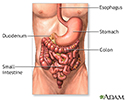Stools - pale or clay-colored
Stools that are pale, clay, or putty-colored may be due to problems in the biliary system. The biliary system is the drainage system of the gallbladder, liver, and pancreas.
The liver releases bile salts into the stool, giving it a normal brown color. You may have clay-colored stools if you have a liver infection that reduces bile production, or if the flow of bile out of the liver is blocked.
Yellow skin (jaundice) often occurs with clay-colored stools. This may be due to the buildup of bile chemicals in the body.
Causes
Possible causes for clay-colored stools include:
- Alcoholic hepatitis
- Biliary cirrhosis
- Cancer or noncancerous (benign) tumors of the liver, biliary system, or pancreas
- Cysts of the bile ducts
- Gallstones
- Some medicines
- Narrowing of the bile ducts (biliary strictures)
- Sclerosing cholangitis
- Structural problems in the biliary system that are present from birth (congenital)
- Viral hepatitis
There may be other causes not listed here.
When to Contact a Medical Professional
Contact your health care provider if your stools are not the normal brown color for several days.
What to Expect at Your Office Visit
The provider will perform a physical exam. They will ask questions about your medical history and symptoms. Questions may include:
- When did the symptom first occur?
- Is every stool discolored?
- What medicines do you take?
- What other symptoms do you have?
Tests that may be done include:
- Blood tests, including tests to check liver function and for viruses that might affect the liver
- Endoscopic retrograde cholangiopancreatography (ERCP)
- Imaging studies, such as an abdominal ultrasound, CT scan, or MRI of liver and bile ducts
References
Korenblat KM, Berk PD. Approach to the patient with jaundice or abnormal liver tests. In: Goldman L, Schafer AI, eds. Goldman-Cecil Medicine. 26th ed. Philadelphia, PA: Elsevier; 2020:chap 138.
Lidofsky SD. Jaundice. In: Feldman M, Friedman LS, Brandt LJ, eds. Sleisenger and Fordtran's Gastrointestinal and Liver Disease. 11th ed. Philadelphia, PA: Elsevier; 2021:chap 21.
Marks RA, Saxena R. Liver diseases of childhood. In: Saxena R, ed. Practical Hepatic Pathology: A Diagnostic Approach. 2nd ed. Philadelphia, PA: Elsevier; 2018:chap 5.
Review Date: 7/30/2022
Reviewed By: Michael M. Phillips, MD, Emeritus Professor of Medicine, The George Washington University School of Medicine, Washington, DC. Also reviewed by David C. Dugdale, MD, Medical Director, Brenda Conaway, Editorial Director, and the A.D.A.M. Editorial team.










